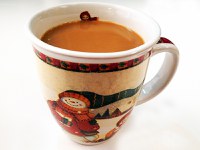Prairie Fare: Sip Slowly and Enjoy Special Beverages
(Click the image below to view a high-resolution image that can be downloaded)
Julie Garden-Robinson, Food and Nutrition Specialist
NDSU Extension Service
“The mocha frappe sounds interesting,” my 15-year-old daughter said as we stood at the restaurant counter. She went to find a booth.
I admit I was a little preoccupied thinking about the day’s tasks. I heard “mocha” and figured she wanted her usual hot mocha drink on a cold day.
I arrived at the booth and distributed the beverages and food to my family. My daughter tasted her drink and announced with surprise: “It’s hot!”
“You really wanted an icy drink on the coldest day so far this year?” I replied.
My husband looked at me as though I had dropped off her dog at the pound.
“Oh, this will be OK,” she said. She looked at me with puppy-dog eyes just as her dog does when he wants a treat. I wasn’t keen on spending $4 on another beverage.
She decided she wanted a snack, so my husband went to buy it and returned with the snack and a mocha frappe. Dads like to “spoil” their daughters, I guess.
She proceeded to alternately drink her hot and cold mocha. I sipped my economical, calorie-free cup of coffee. I’m not a teen anymore by a long shot. I’d be buying larger-sized jeans next week if I drank all those calories.
My husband and daughter flipped over the tray liner and began reading the calories.
“Wow!” they said as their eyes widened. My teen was going to be wired with energy. The small, cold mocha had 450 calories and the small, hot mocha had 330 calories. The restaurant didn’t list the caffeine content.
Fortunately, she drank half of each beverage and put the rest in the fridge at home for the next day.
Beverages choices can make a major difference in our daily diet. Many people do not realize how many calories can be contributed by their nondiet sodas, special coffees or, for adults, any alcohol-containing beverage they might have.
Many people enjoy sweetened soda on a daily basis. A 20-ounce sweetened soda per day contributes about 230 calories to your diet, or more than 10 percent of the energy an average adult needs in a day (2,000 calories).
Switching to water with a slice of lemon or diet soda could cut those calories from your diet. In theory, cutting 200 calories from your daily diet during the course of a year, without changing anything else diet- or exercisewise, could result in a 20-pound weight loss.
If you enjoy a 16-ounce medium café latte with whole milk, you are drinking 265 calories. Swapping this beverage with a small latte made with fat-free milk trims your treat to 125 calories. Making that simple swap could trim your waistline by the next season.
Consider these tips:
- If you want to enjoy a special beverage, order the smallest size.
- Save calories and trim fat by ordering beverages with fat-free or low-fat milk instead of whole milk.
- Leave off the whipped topping.
- Choose water with a lemon or lime slice to trim calories and money from your restaurant bill
Many people welcome a special holiday coffee or tea beverage. Sip it slowly and enjoy it.
Check out the holiday beverages available at http://www.ag.ndsu.edu/pubs/yf/foods/fn1625.pdf. Here is one of the featured recipes that can be placed in a wide-mouth glass jar and given to friends.
Mint Candy Coffee Mix
1/3 c. instant coffee (regular or decaffeinated)
1 c. instant skim milk powder
1/2 c. powdered nondairy coffee creamer
1/2 c. white sugar
1/4 c. unsweetened cocoa powder
1/4 c. instant chocolate pudding mix
6 to 8 red and white striped candy mints, crushed
Add the ingredients to a food processor. Pulse until thoroughly mixed and you have a smooth powder. Store mixture in an airtight, quart-sized container. Decorate container as desired (with ribbon, fabric, etc.)
For each serving, place 3/4 cup of boiling water in a mug and stir in 3 tablespoons of the mix.
Makes nine servings. Each serving has 110 calories, 1.5 grams (g) of fat, 3 g of protein, 23 g of carbohydrate, 1 g of fiber and 120 milligrams of sodium.
(Julie Garden-Robinson, Ph.D., R.D., L.R.D., is a North Dakota State University Extension Service food and nutrition specialist and professor in the Department of Health, Nutrition and Exercise Sciences.)
NDSU Agriculture Communication – Dec. 5, 2013
| Source: | Julie Garden-Robinson, (701) 231-7187, julie.garden-robinson@ndsu.edu |
|---|---|
| Editor: | Rich Mattern, (701) 231-6136, richard.mattern@ndsu.edu |


